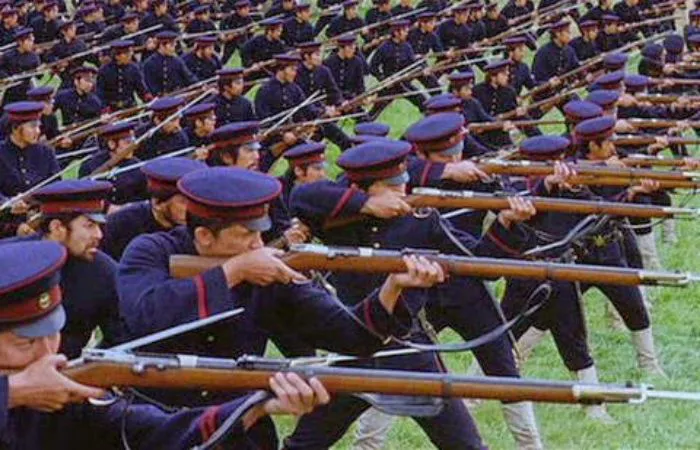In the historical epic film “The Last Samurai,” directed by Edward Zwick and starring Tom Cruise, the conflict between traditional samurai warriors and modernized Japanese forces is a central theme. The narrative revolves around the introduction of modern weaponry and military tactics by the Imperial Japanese Army (IJA) during the Meiji Restoration era (late 19th century), which posed a significant challenge to the traditional samurai way of life. Let’s explore the new weapons and military technologies introduced by Japan’s new army in the film and their impact on the samurai.
Historical Context: Meiji Restoration and Modernization
The Meiji Restoration period (1868-1912) marked a transformative era in Japanese history, characterized by efforts to modernize and Westernize the country. The restoration led to the dismantling of the feudal system, including the decline of the samurai class, and the establishment of a centralized imperial government.
Key aspects of the Meiji Restoration include:
End of Feudalism: The restoration abolished the feudal system, centralizing political power under the emperor and dismantling the authority of feudal lords (daimyo) and their samurai retainers.
Western Influence: The Meiji government implemented sweeping reforms inspired by Western models, including the adoption of Western technologies, military tactics, and administrative systems.
Introduction of Modern Weapons in “The Last Samurai”
In “The Last Samurai,” the Imperial Japanese Army introduces advanced weaponry and military tactics that challenge the traditional martial prowess of the samurai:
Rifles and Firearms:
The IJA employs rifles and firearms, including breech-loading rifles and early machine guns, such as the Gatling gun. These weapons offer significant firepower and range advantages over traditional samurai weapons like swords and bows.
Artillery and Cannons:
The use of artillery and cannons by the IJA demonstrates their capability to engage in long-range combat and siege warfare, disrupting traditional samurai tactics based on close-quarter melee combat.
Military Strategy:
The IJA’s military strategy emphasizes disciplined formations, coordinated maneuvers, and combined arms tactics, reflecting Western military doctrines that prioritize efficiency and firepower.
Impact on Samurai and Traditional Warfare
The introduction of modern weapons and military technologies by the IJA profoundly impacts the traditional samurai way of life:
Tactical Disadvantages:
Samurai warriors, accustomed to honor-bound duels and melee combat, struggle to adapt to the IJA’s ranged warfare tactics and overwhelming firepower.
Cultural Conflict:
The clash between modern military technologies and traditional samurai values symbolizes a broader cultural conflict between tradition and progress, highlighting the challenges of societal transformation during the Meiji Restoration.
Strategic Realities:
The film portrays the strategic dilemmas faced by samurai leaders, who must reconcile their loyalty to tradition with the practical realities of modern warfare.
Symbolism and Themes
“The Last Samurai” explores themes of cultural identity, honor, and resilience amidst societal change. The conflict between samurai and the IJA serves as a metaphor for Japan’s struggle to balance tradition and modernity during a pivotal period in its history.
Historical Accuracy and Interpretation
While “The Last Samurai” is a work of fiction, it draws inspiration from historical events and cultural themes of the Meiji Restoration era. The film’s portrayal of modern warfare reflects broader historical dynamics and technological innovations that transformed Japan’s military landscape.
Conclusion
In conclusion, “The Last Samurai” depicts the introduction of modern weaponry and military tactics by Japan’s new army during the Meiji Restoration era. The film captures the profound impact of technological innovation on traditional samurai culture and warfare, highlighting the complexities of societal transformation and cultural resilience in the face of change. Through its portrayal of historical themes and dramatic storytelling, “The Last Samurai” invites audiences to reflect on the enduring legacy of Japan’s feudal past and its ongoing relevance in contemporary society.
Related Topics:
Shogun & Samurai – What Do They Mean?

